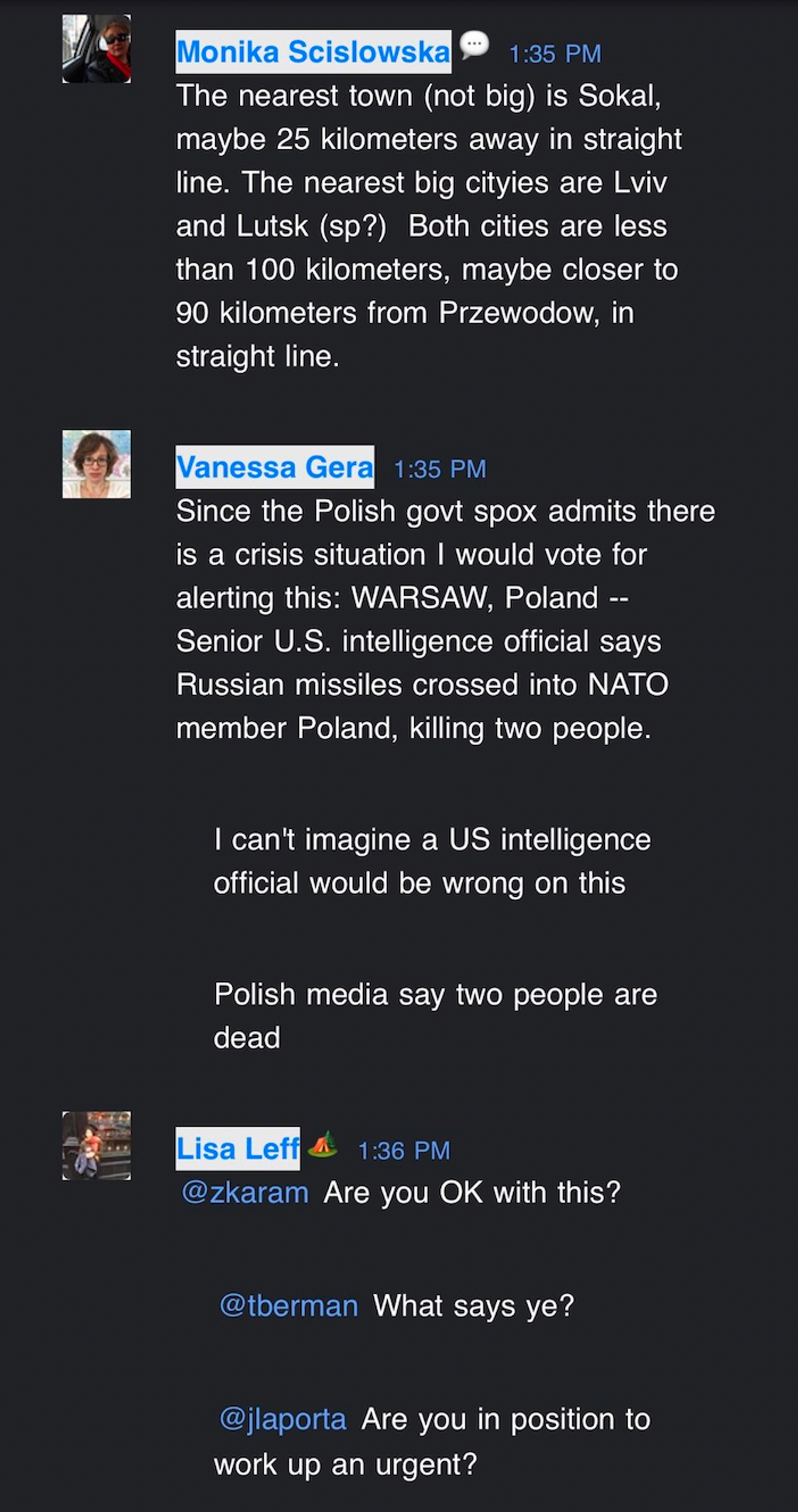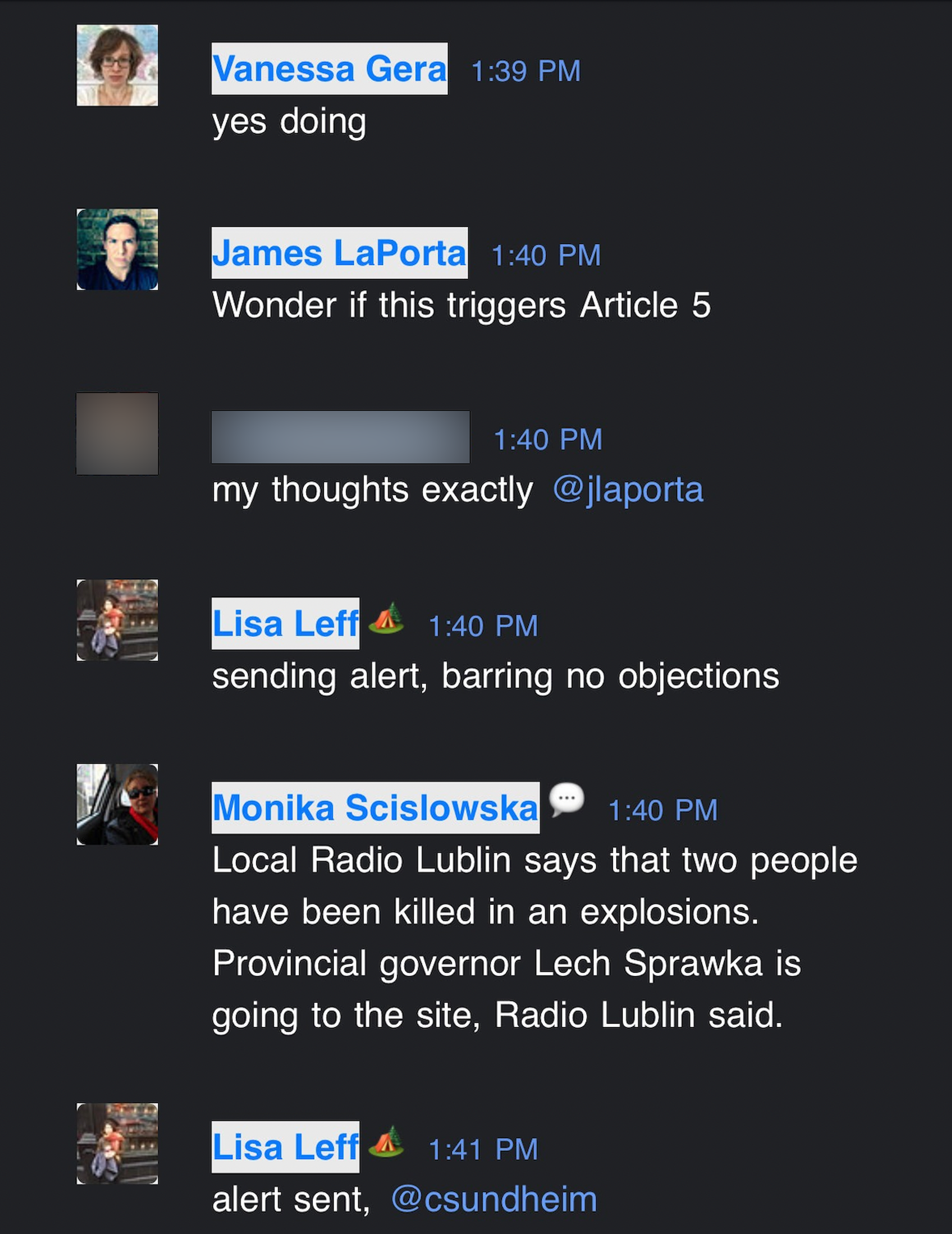The Scoop




A 10-minute miscommunication on Slack between journalists at the Associated Press resulted in an erroneous report last week that appeared momentarily to bring tensions between NATO and Russia to their highest point since the Cuban Missile Crisis.
Last Tuesday, AP posted a news alert saying that a “senior U.S. intelligence official says Russian missiles crossed into NATO member Poland, killing two people,” and noting that leaders in Poland were “holding an emergency meeting due to a ‘crisis situation.’”
The report, which would have represented a Russian missile striking a member of NATO, immediately sparked fear of a dramatic escalation of tensions between the US and Russia.
But national security officials said the report was false, and the Associated Press retracted the piece a day later. On Monday, it fired James LaPorta, the national security reporter for the wire service who got the initial tip that set the story in motion.
LaPorta’s firing was first reported by the Daily Beast, and confirmed by the Washington Post. Both stories quoted AP sources and put the blame squarely on the reporter. The Beast reported that LaPorta left “the impression that the story’s sourcing had been approved.”
But the slack messages on which the incident played out tell a different story, of honest mistakes, internal confusion, and a lack of a clear process that led to a disaster for one of the few news organizations whose Twitter presence is an authoritative account of world affairs.
On Tuesday afternoon at 1:32 PM ET, LaPorta wrote in an internal Slack channel that he’d been told by a senior US intelligence source that Russian missiles crossed into Moldova and Poland. LaPorta described the source as an “official (vetted by Ron Nixon),” referring to the publication’s VP of news and investigations.
But while Nixon had approved the use of that specific anonymous source in the past, people involved said, Nixon was not aware of that tip or that story. LaPorta did not exactly claim that Nixon had approved the source in this case, but his words were interpreted by the editors to mean that he did.
Lisa Leff, an editor on the European desk, immediately asked if the wire service could send an AP alert, or if they would need confirmation from another source.
“That call is above my pay grade,” LaPorta replied.
When Leff asked if LaPorta could put together a story, he told the Slack channel that he was not around.
“I’m actually at a doctor’s appointment. What I passed along is all I know at the moment,” he said.
Deputy European news editor Zeina Karam ultimately decided to publish, believing that Nixon had vetted the source, and the alert was sent out at 1:41 PM ET, less than ten minutes after LaPorta’s initial message.
But the story was false. The initial tip may have been a true accounting of what senior officials thought in the minutes after the explosion in Poland. But it was wrong, as is often true amid the fog of war and wartime journalism. NATO officials later determined that the missiles were likely fired by Ukrainian air defense. The Associated Press took the story down, and issued a correction saying that “subsequent reporting showed that the missiles were Russian-made and most likely fired by Ukraine in defense against a Russian attack.”
LaPorta was suspended on Thursday morning, according to a source familiar with the situation, and fired on Monday after a review by the wire service.
In a statement to Semafor, he said that he would “love to comment but I’ve been ordered by AP not to comment.”
Max’s view
The Associated Press blasts alerts out to its hundreds of news partners around the world at lightning speed, and updates stories continually as they evolve. But the fact that a story that theoretically could’ve triggered armed conflict between NATO and Russia required less than ten minutes, one anonymous source, and just over a dozen Slack messages for the wire service to publish suggests a systemic editorial failure, not one reporter’s blunder.
The central miscommunication came when LaPorta wrote that his source had been vetted by Nixon. AP decided that this constituted a violation of the organization’s policies, which require sources to be vetted every time.
But LaPorta didn’t say Nixon had approved the source for that story. His ambivalence about publishing the item at all, and the fact that he said he was not present to write the story, left the decision in his editor’s hands. They hit publish. The Slack exchange shows no indication that editors considered the geopolitical ramifications of the report. And there’s no indication they sought a second source.
AP did not anticipate disciplining the editors for the blunder, a spokesperson told the Washington Post.
Room for Disagreement
The Associated Press said the incident was part of a pattern of behavior. In a statement, spokesperson Lauren Easton said that the publication is continuing to review the incident. But she implied that the decision to fire LaPorta was not based just on last week’s story, though she did not clarify what those incidents were.
“When our standards are violated, we must take the steps necessary to protect the integrity of the news report. We do not make these decisions lightly, nor are they based on isolated incidents,” she said.
She continued: “The story did not meet our standards. We continue to look into every aspect of what happened.”
The View From Moscow
Russian officials have pointed to the deadly incident, and to the rush to blame Russian missiles, as evidence of a Western propaganda effort.
“The incident with the Ukrainian-alleged ‘missile strike’ on a Polish farm proves just one thing: waging a hybrid war against Russia, the West moves closer to the world war,” former Russian President Dmitry Medvedev, who is deputy head of the country’s security council, tweeted.
AP sources do not believe that the initial tip was deliberate misinformation, they told Semafor.
Editor’s note
For security reasons, Semafor has blurred the name of one junior staffer in the Slack messages who didn’t play a role in the incident.